how is transcription similar to replication what is the purpose of transcription
Deoxyribonucleic acid (deoxyribonucleic acid) is one of the almost of import molecules in your body, and though around 99.9% of your Deoxyribonucleic acid is the same as that of every other homo, the 0.ane% that'due south different is what makes you genetically unique! This tiny biological structure is the ultimate instruction manual, containing the "recipes" for the proteins your body needs to develop and part. Today, we're going to give you lot a primer on the basics of Dna. Nosotros'll talk virtually its structure, how it replicates, and the function information technology plays in the production of proteins. March 2022 Update: Did you know that in the boilerplate man cell, there is about 2m (6ft) of DNA? That'south pretty impressive, considering that even the largest cells are just over 100µm in diameter. (That's actually tiny, by the way—1µm is 1 millionth of a meter.) Meet how yous tin teach and learn about Dna and chromosome structure in Visible Biology. How is all that genetic fabric packed into a space way smaller than the caput of a pin? The short answer is a whole lot of twisting and winding. Dna wraps around protein clusters chosen histones to form units called nucleosomes. These nucleosomes fold into a zig-zag patterned cobweb, which and so forms loops. There are 46 separate strings of Dna in each somatic cell of the human body. Each ane of these is called a chromosome. Scientists group them into 23 homologous pairs, which means that the chromosomes in each pair are similar in structure and office. The just exception to this is the 23rd pair—the sexual activity chromosomes—in biologically male individuals. X and Y sex chromosomes simply take certain regions (autosomal regions) that are homologous. At the molecular level, DNA has a feature double-helix shape, and though this wasn't observed past scientists until mid-20th century, it has speedily become i of the most iconic shapes in all of scientific discipline. Lesson on Dna construction from the Visible Biology YouTube series with Dr. Cindy Harley. The sides of this twisted ladder are composed of alternating molecules of saccharide (deoxyribose, to be precise) and a phosphate group. Each side is named for the management it runs in (5'–3' or iii'–v'). The ladder'south "steps" are composed of two nitrogenous bases, held together with hydrogen bonds. Four nitrogenous bases—cytosine, thymine, adenine, and guanine—tin can be constitute on strands of DNA. In terms of their chemical structure, cytosine and thymine are pyrimidines and adenine and guanine are purines. Adenine and thymine (A and T) always pair together, and guanine and cytosine (G and C) ever pair together. They pair this style considering A and T form two hydrogen bonds with each other and One thousand and C course three. At the most bones level, different sections of Deoxyribonucleic acid strands (sequences of nitrogenous bases) provide instructions for the synthesis of proteins. A single department of DNA can even code for multiple proteins! Replication of a cell's Dna occurs before a jail cell prepares to undergo division—either mitosis or meiosis I. It takes place in three(ish) steps. Want to know something neat? When a DNA molecule replicates, each of the resulting new Dna molecules contains a strand of the original, so neither is completely "new." As well, new histones are made at the aforementioned fourth dimension the Dna replicates and so that the new strands of Deoxyribonucleic acid can curl around them. Before we talk over transcription and translation, the two processes cardinal to poly peptide synthesis, we need to talk about another kind of molecule: RNA. RNA is a lot similar DNA—it's got a saccharide-phosphate backbone and contains sequences of nitrogenous bases. However, at that place are a couple of vital differences betwixt RNA and DNA: There are several different types of RNA, each with different functions, but for the purposes of this article, we're going to focus on messenger RNA (thousandRNA) and transfer RNA (tRNA). Transcription is the first phase of the protein-making process, even though the actual protein synthesis doesn't happen until the second stage. Essentially, what happens during transcription is that an mRNA "copies down" the instructions for making a poly peptide from DNA. First, an enzyme called RNA polymerase opens up a section of DNA and assembles a strand of 1000RNA by "reading" the sequence of bases on 1 of the strands of Deoxyribonucleic acid. If in that location's a C on the Deoxyribonucleic acid, there will be a Yard on the RNA (and vice versa). If there'due south a T on the DNA, there will be an A on the RNA, just if there'south an A on the Deoxyribonucleic acid, there will be a U (instead of a T) on the RNA. As the RNA polymerase travels down the string of DNA, it closes the helical structure back up after it. Earlier the new mRNA can get out to deliver its protein fabrication instructions, it gets "cleaned up" by enzymes. They remove segments chosen introns and then splice the remaining segments, called exons, together. Exons are the sequences that actually lawmaking for proteins, so they're the ones the mRNA needs to go on. You can think of introns like padding between the exons. Also, remember how I mentioned that a unmarried sequence of Deoxyribonucleic acid can lawmaking for multiple proteins? Culling splicing is the reason why: before the mRNA leaves the nucleus, its exons can exist spliced together in unlike ways. Lesson on transcription from the Visible Biology YouTube series with Dr. Cindy Harley. After it's all cleaned up and ready to become, the thouRNA leaves the nucleus and goes out to fulfill its destiny: taking office in translation, the second half of protein construction. Lesson on translation from the Visible Biology YouTube serial with Dr. Cindy Harley. In the cytoplasm, the mRNA must interface with tRNA with the help of a ribosome. tRNA is a type of RNA that has a identify to demark to free amino acids and a special sequence of three nitrogenous bases (an anticodon) that binds to the ribosome. Ribosomes are organelles that facilitate the meeting of tRNA and thouRNA. During translation, ribosomes and tRNA follow the instructions on the mRNA and assemble amino acids into proteins. Each ribosome is made upwardly of two subunits (large and small). These come together at the start of translation. Ribosomal subunits can unremarkably be found floating effectually in the cytoplasm, but a ribosome will dock on the rough endoplasmic reticulum if the protein it'south making needs to be put into a transport vesicle. Ribosomes likewise have three binding sites where tRNA can dock: the A site (aminoacyl, first position), the P site (peptidyl, second position) and the Due east site (the go out position). Ultimately, translation has three steps: initiation, elongation, and termination. During initiation, the strand of mRNA forms a loop, and a modest ribosomal subunit (the bottom of the ribosome) hooks onto it and finds a sequence of bases that signals it to begin transcription. This is called the start codon (AUG). Then, a tRNA with UAC anticodon pairs with this starting time codon and takes upwards the second position (P) site of the ribosome. This tRNA carries the amino acid Methionine (Met). At this point, the large ribosomal subunit gets in position as well (it's above the mRNA and the small subunit is below). In the elongation phase, the fully-assembled ribosome starts to slide along the mRNA. Let's say the side by side sequence of bases it encounters after the showtime codon is GCU. A tRNA molecule with the anticodon CGA will demark to the commencement position (A) site of the ribosome. The amino acid it's carrying (alanine) forms a peptide bond with Met. Afterwards, the CGA tRNA (conveying the Met-Ala chain) moves to the second position and the UAC tRNA enters the Due east binding site. The first position site is then ready to accept a new tRNA. This process keeps going until the ribosome gets to a "stop" codon. Termination is pretty much what it sounds like. Upon reaching the "stop" codon, the tRNA that binds to the offset position carries a protein called a release factor. The amino acrid concatenation and then breaks off from the ribosome, either going off into the cytosol or into the cisterna of the rough ER, and the ribosome disassembles. Nonetheless, it might very well reassemble and go effectually the mRNA loop again. Also, multiple ribosomes can work on the same mRNA at once! And those are the basics of DNA! Here's a handy chart you can look at if you lot need to remember the differences betwixt transcription, translation, and replication: Location Purpose Main Participants Product(due south) Replication Nucleus Duplicate a full strand of DNA Deoxyribonucleic acid 2 identical strands of DNA Transcription Nucleus Use a strand of DNA to build a molecule of yardRNA Dna mRNA Translation Cytoplasm Apply mRNA to build an amino acid chain mRNA tRNA (and amino acids) Amino acid chain (poly peptide) For more information about the construction of Deoxyribonucleic acid and chromosomes, bank check out our Dna eBook! Be certain to subscribe to theVisible Torso Blog for more anatomy awesomeness! Are yous an instructor? We have award-winning 3D products and resources for your anatomy and physiology grade!Learn more here. Additional Sources:
Visible Biology is now available! Visible Biology is a visual guide to important biological concepts and processes, including Deoxyribonucleic acid and chromosomes, prokaryotic vs. eukaryotic cells, monocot and dicot plant structures, blood cells, photosynthesis, and more.The Structure of DNA: Astounding Biological Powers...Itty Bitty Living Space
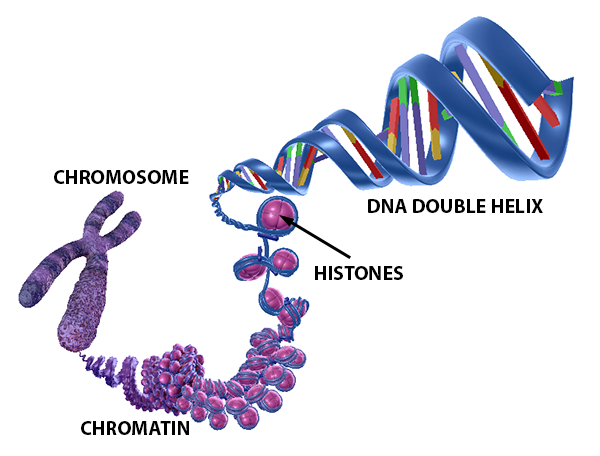 DNA structure and storage. Image from Visible Biological science.
DNA structure and storage. Image from Visible Biological science. 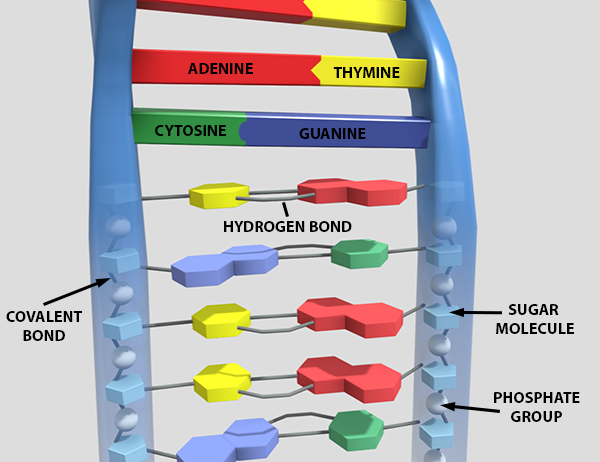 Molecular construction of Deoxyribonucleic acid. Image from Visible Biology.
Molecular construction of Deoxyribonucleic acid. Image from Visible Biology. Replication: Doubling Up on DNA
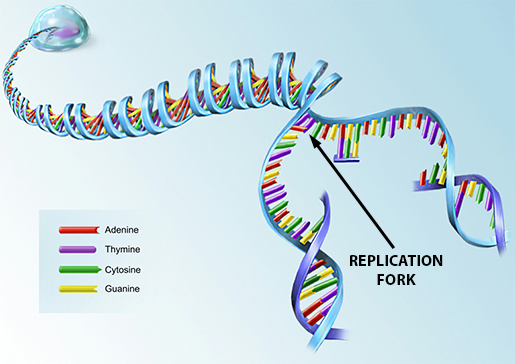 Illustration from A&P 6.
Illustration from A&P 6.
Interlude: RNA vs DNA
Making a Protein, Part 1: Transcription
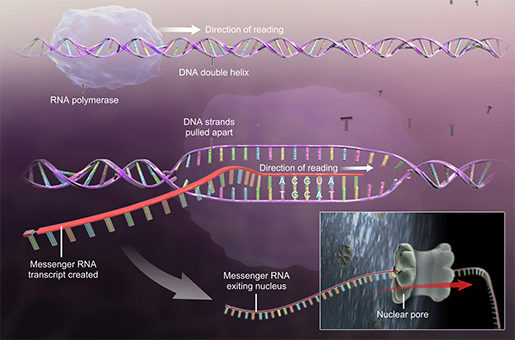 Illustration from A&P half dozen.
Illustration from A&P half dozen. Making a Protein, Part two: Translation
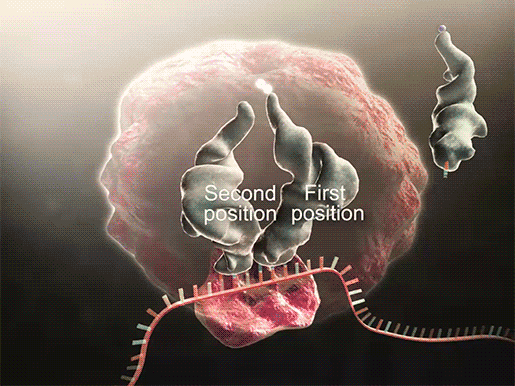 Video footage from animation in Visible Biology.
Video footage from animation in Visible Biology.
Dna helicase
DNA polymerase
DNA ligase
RNA polymerase
(DNA ligase)
Ribosome
If you desire to learn more about cells, cheque out these related VB Web log posts:

Share
Source: https://www.visiblebody.com/blog/dna-and-rna-basics-replication-transcription-and-translation
Post a Comment for "how is transcription similar to replication what is the purpose of transcription"